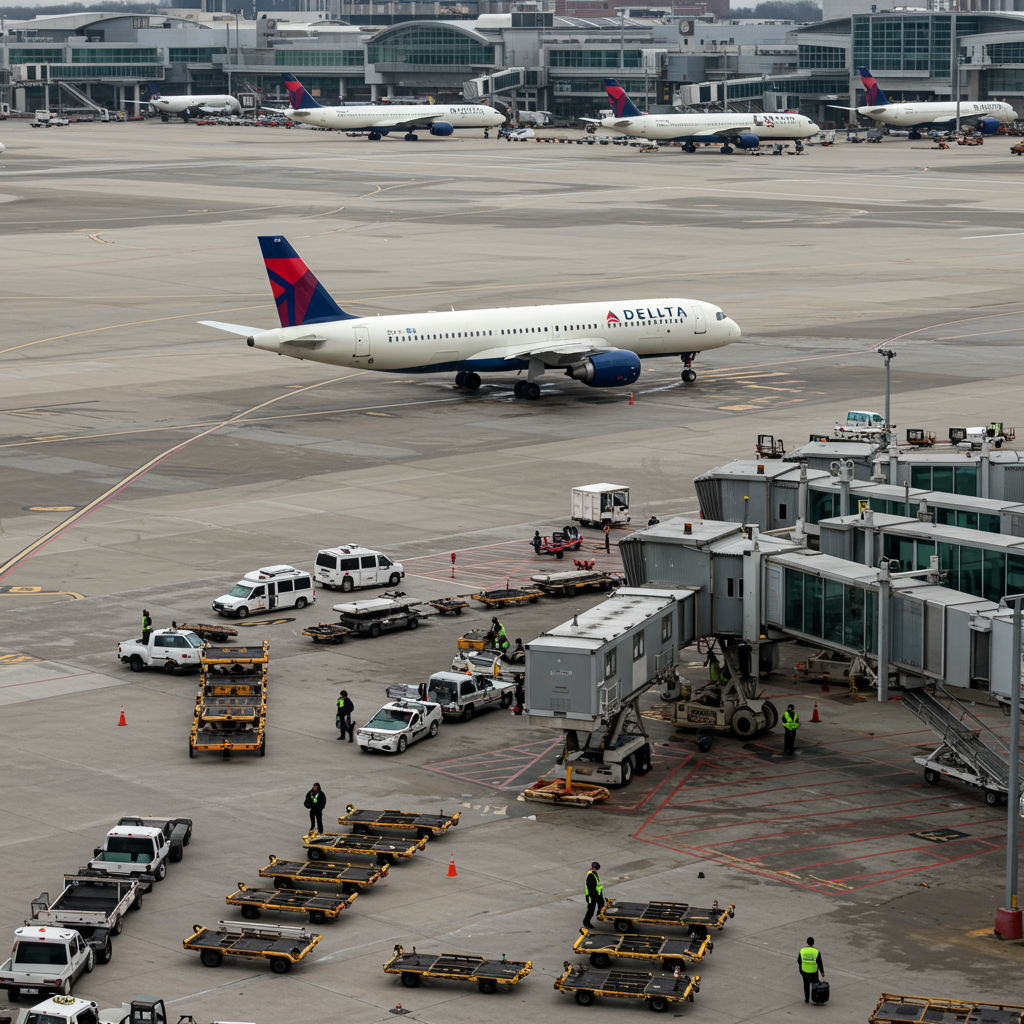<a href="https://news.quantosei.com/2025/06/29/severe-storms-force-evacuation-of-atlanta-airport-control-tower-disrupting-holiday-travel/” title=”Severe Storm Shuts Down Atlanta Airport Tower, Delays Hit”>delta Air Lines successfully stabilized its extensive flight operations by Sunday, June 29, 2024, following significant disruptions caused by severe thunderstorms that impacted its main hub in Atlanta days earlier. The powerful weather system on Friday, June 27, wreaked havoc at Hartsfield-Jackson Atlanta International Airport (ATL), leading to widespread delays, hundreds of cancellations, and cascading challenges across Delta’s network. While Saturday saw continued operational hurdles, swift recovery efforts allowed the airline to achieve much-needed stability by the end of the weekend, bringing relief to thousands of affected travelers.
Weekend Travel Chaos: Severe Storms Cripple Delta’s Atlanta Hub
Intense thunderstorms descended upon Atlanta on the evening of Friday, June 27. These severe weather conditions included heavy rain, frequent lightning, hail, and strong winds, with reports of damaging microbursts near the airport. As the world’s busiest airport and Delta’s largest operational center, ATL is critical to the airline’s schedule, handling around 900 flights daily. The storm’s direct impact on this vital hub quickly escalated into a major network disruption.
The hazardous conditions triggered immediate safety measures. The Federal Aviation Administration (FAA) issued a flash flood warning for the area. Crucially, high winds necessitated a temporary evacuation of most air traffic controllers from the ATL control tower. While a small team remained to manage essential communications, the disruption significantly slowed air traffic management. Reports also indicated a brief power loss at the tower.
The direct consequences for Delta passengers were immediate and severe. According to flight tracking data from Friday evening, the storm contributed to over 1,000 delayed flights and approximately 170 cancellations specifically at ATL. Departing flights faced average delays ranging from 16 to 30 minutes, while incoming flights saw significantly longer holds, averaging 75 minutes. The FAA imposed a restriction, holding all incoming flights at their departure airports until at least midnight Saturday to ensure safety during the storm’s peak. Over 90 Delta flights were also forced to divert to other airports to wait out the weather.
Beyond the immediate grounding and delays, the storms caused physical impacts. The hail, in particular, necessitated thorough safety inspections for over 100 Delta aircraft. Ensuring structural integrity and overall airworthiness after potential hail damage was a critical step before these planes could return to service. This requirement further complicated the process of resetting the airline’s schedule.
The operational challenges were compounded by the timing. The severe weather struck just as travelers were beginning to move for the busy Fourth of July holiday weekend. Managing the disruption at its primary hub during a high-volume travel period created substantial difficulties for Delta in restoring its schedule and assisting the numerous passengers left stranded or facing significant delays.
Navigating the Disruption: Delta’s Recovery Efforts
In the wake of the storm, Delta Air Lines mobilized teams across its organization to tackle the extensive operational challenges. The primary focus was on achieving operational recovery while prioritizing customer care and safety.
Maintenance teams worked tirelessly through the night following the Friday storm. Their crucial task was completing the required inspections on the over 100 potentially affected aircraft. By Saturday morning, these efforts allowed many of the grounded planes to be cleared and returned to service, a vital step in rebuilding the operational readiness.
Operations teams concentrated on the complex task of getting crews back on schedule. Repositioning pilots and flight attendants who were displaced by cancellations and diversions is a significant logistical challenge after a major disruption. Getting crew members to the correct locations to operate scheduled flights was essential for restoring the network.
A wide range of Delta personnel contributed to assisting impacted customers. This included pilots, flight attendants, and airport staff working directly with passengers at affected locations. Teams at reservations centers handled rebookings and inquiries, while volunteers from Delta’s headquarters also pitched in to support frontline efforts and help stranded travelers.
Delta emphasized using its digital tools for the latest information and assistance. The Fly Delta app was recommended as the best resource for checking flight status, managing trips, accessing rebooking options, and generally navigating the disruption. The airline’s website, Delta.com, also provided essential flight status updates. Recognizing that customers might incur expenses due to the delays and cancellations, Delta provided information on how to submit claims through an online expense reimbursement form, outlining the process for recouping reasonable costs.
Delta’s Chief Customer Experience Officer, Erik Snell, issued a public message to customers. He acknowledged the significant disruption caused by the severe weather and apologized that the event fell short of the reliability and service standards customers expect from the airline. He reiterated the severity of the storm’s impact, including the hundreds of cancellations, diversions, and delays, as well as the necessary aircraft inspections. The airline affirmed its commitment to safely restoring operations as quickly as possible and maintaining a strong focus on customer care throughout the challenging recovery period.
Stability Achieved: Operations Normalize by Sunday
By Sunday, June 29, Delta Air Lines had made significant headway in recovering from the severe weather system. The airline’s operational status showed remarkable improvement compared to the height of the disruption on Friday and the continued challenges faced on Saturday.
An editor’s note updated on Sunday confirmed the positive trend. Delta’s operations had stabilized considerably by this point. The number of mainline cancellations reported for Sunday was less than 60. This represented a drastic reduction from the hundreds of cancellations seen over the preceding two days.
Crucially, the update indicated that no further operational disruption was expected specifically as a result of the severe weather event that occurred on Friday. This signaled that the direct impact of the storm had been mitigated and the airline was moving past the immediate crisis phase. The ability to recover to this level of stability relatively quickly after such a significant weather event at its primary hub highlights the intensive efforts undertaken by Delta’s teams. The airline expressed gratitude for the patience and understanding demonstrated by its customers throughout the difficult period, acknowledging the inconvenience and frustration caused by the widespread disruptions.
The successful stabilization by Sunday allowed Delta to begin the process of fully resetting its network and addressing the backlog of passengers and operational irregularities created by the storm. While the full impact on every passenger’s journey may have taken slightly longer to resolve, the core operational system had returned to a more normal state.
Frequently Asked Questions
What caused Delta’s flight disruptions in Atlanta on June 27-28?
Delta’s significant flight disruptions at Hartsfield-Jackson Atlanta International Airport (ATL) on June 27 and 28, 2024, were caused by severe thunderstorms. These storms brought heavy rain, lightning, hail, and strong winds, impacting airport operations. Key issues included a temporary evacuation of the air traffic control tower, a brief power outage, the need for safety inspections on over 100 aircraft due to potential hail damage, and FAA-imposed ground stops for incoming flights.
How could affected Delta passengers get information or assistance during the storm disruption?
Delta advised passengers impacted by the June storm disruptions to use digital resources for help and updates. The Fly Delta app was the primary tool recommended for checking the latest flight status, managing reservations, and accessing rebooking options. The airline’s website, Delta.com, also provided flight status information. For passengers who incurred eligible expenses like meals or accommodation due to the disruption, Delta made an online expense reimbursement form available for submitting claims.
Were Delta’s operations back to normal by Sunday, June 29th?
By Sunday, June 29, 2024, Delta Air Lines reported that its operations had stabilized significantly. While not necessarily operating at 100% of the standard schedule without any minor issues, the major disruptions directly caused by the severe weather had subsided. The number of mainline cancellations for Sunday was less than 60, indicating a substantial improvement from the hundreds seen on previous days. Delta stated that no further disruption specifically from the Friday storm event was anticipated by Sunday.
Conclusion
The severe thunderstorms that struck Atlanta on Friday, June 27, presented a formidable challenge to Delta Air Lines, causing extensive flight disruptions at its primary hub and across its network. The event highlighted the vulnerability of complex airline operations to severe weather, leading to widespread delays, cancellations, and the necessity for crucial safety measures like aircraft inspections. Despite the scale of the disruption and the unfortunate impact on countless travelers navigating the start of a busy holiday weekend, Delta’s focused efforts on maintenance, crew recovery, and customer support allowed the airline to achieve significant operational stabilization by Sunday, June 29. This relatively swift return to normalcy underscored the effectiveness of the airline’s recovery teams and processes following a major weather-related event, enabling Delta to move past the immediate crisis and begin fully addressing the backlog of affected passengers and logistics.




